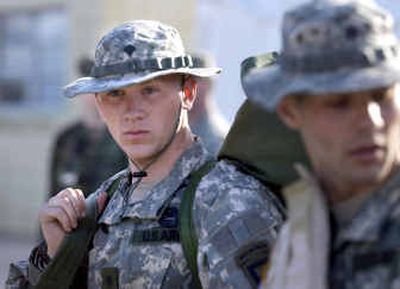Army soldiers getting new combat fatigues

FORT STEWART, Ga. – Army soldiers are being issued new fatigues with easy-to-use Velcro openings and a redesigned camouflage pattern that can help conceal them as they move rapidly from desert to forest to city in places like Baghdad.
“It might give you the extra second you need, save your life maybe,” Sgt. Marcio Soares said Tuesday after trying on the new all-in-one camouflage uniform that is the first major redesign in Army fatigues since 1983.
Soares’ unit, the Georgia National Guard’s 48th Infantry Brigade, is the first to be issued the new fatigues as part of a $3.4 billion Army-wide makeover being phased in over the next three years.
The uniform will replace the standard forest camouflage – green, brown and black – and the desert camouflage – tan, brown and gray – now used by U.S. troops in Iraq.
Twenty-two changes were made to the uniforms, most notably the new camouflage pattern.
Instead of bold jigsaw swatches of colors, the new camouflage pattern uses muted shades of desert brown, urban gray and foliage green broken into one-centimeter segments. Black was eliminated completely because it catches the eye too easily.
The resulting camouflage – similar to a pattern the Marines adopted two years ago – conceals soldiers in forest, desert or urban battlegrounds, said Sgt. 1st Class Jeff Myhre, the uniform’s lead designer.
“In Baghdad, you can go from the desert to vegetation to the city in 10 minutes,” Myhre said. “What we realized very quickly is there’s no camouflage that’s the 100 percent solution for any environment.”
Other changes were prompted by complaints from soldiers in the field. Jacket and pocket buttons, which can snag on nets and other gear, have been replaced with zippers and Velcro.
Pockets at the jacket’s waistline were moved to the shoulders, where soldiers can reach them while wearing body armor. And the uniforms have a looser fit, with more room to wear layers underneath.
Rank, unit and name patches attach with Velcro rather than being sewn on. Infrared-reflecting squares on the shoulders make friendly troops easier to identify while using night-vision goggles.
“The only problem I have with the uniform is, once the soldiers put it on, they don’t want to take it off,” said Brig. Gen. Stewart Rodeheaver, commander of the 48th Infantry Brigade, which has 4,000 reservists training at Fort Stewart to go off to Iraq in May.
Col. John Norwood, the Army’s project manager for soldier equipment, said the new uniforms will be issued in coming months to units being sent to Iraq. New soldiers entering basic training will be issued them by October, and all Army troops will be required to wear them by April 2008.
The new uniforms cost more – $85 each, compared with $60 for the old ones. But Norwood said the Army will save money by having to produce only one combat uniform rather than three – standard greens, desert camouflage and cold-weather fatigues.
And they should make soldiers’ lives easier, too. The fabric is wrinkle-free and machine-washable, and the new suede boots do not require polishing like the old black boots.
“If you have a choice whether you teach them to polish boots or teach them how to survive in battle, we’d rather teach them to survive in battle,” Rodeheaver said.